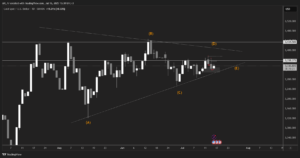The British pound is dropping back again on Friday following a brief rally on Thursday after British Prime Minister Boris Johnson announced his resignation. Stocks are pointing to a weaker start ahead of the non-farm payrolls.
· EURUSD falls to a fresh 20-year low overnight, ECB’s Lagarde will speak later
· GBP/USD has resumed its selloff after Boris Johnson’s resignation yesterday
· US NFP expected to show 270k jobs added, down from 290k
Wall Street closed higher yesterday for a fourth straight session. Yesterday’s rally was partly owing to calming recession fears and partially attributed to reports of massive stimulus spending in China to fire up the economy after the COVID lockdowns. The Nasdaq outperformed, closing 2.8% higher, lifted by chipmakers following encouraging Q2 earnings and guidance from Samsung.
Despite strength on Wall Street, the tone in Asia turned following the shooting of Japan’s former and longest-running Prime Minister Abe. The yen also found a bid on safe-haven flows.
Europe is set for a lower start, with the DAX and the FTSE pointing to a 0.4% decline on the open. The mood is cautious ahead of a speech by ECB’s Lagarde and ahead of US non-farm payrolls.
Lagarde
Lagarde is due to speak on the risks facing the global economy and comes at a time when investors are weighing up the impact of aggressive monetary policy tightening on growth. The EUR/USD has been a notable casualty this week of those fears, falling to 1.0140, a fresh 20-year low overnight, before picking up heading towards the European open.
UK politics
The FTSE and the pound rose yesterday, despite Boris Johnson’s long-awaited resignation. In fact, the pound rose to a session high following the announcement, relieved by the end of the uncertainty. However, the move higher in sterling was short-lived, and GBP/USD is falling again today. With the government’s agenda in limbo amidst the cost of living crisis, souring EU relations, and the deteriorating economic outlook, there appear few reasons to buy the pound.
Non-farm payrolls
Today’s jobs report comes when the focus in the market is almost exclusively on inflation. This is partly the case because the labour market is still so tight. Earlier in the week, the JOLTS job opening report revealed over 11 million vacancies, equating to around two jobs for every unemployed person. Yet, with rising prices and growth expected to slow, will the number of vacancies start to fall?
Initial jobless claims are slowly creeping higher to 235k last week, an almost six-month high. For this month, there is no lead data from the ADP report.
The non-farm payroll is expected to show that 270k jobs were added in June following a 390k increase in May. The unemployment rate is expected to hold steady at 3.6%, and wages are expected to hold steady at 5.2% YoY.
This jobs report is expected to show a slow-down hiring momentum, but nothing dramatic or concerning. Even so, with so much attention on inflation, the Fed is unlikely to steer away from raising interest rates by 50 – 75 basis points. It would take a disastrous report to trigger a sizable re-pricing in the market’s Fed rate expectations. The CPI report next week is likely to be more important.
Disclaimer: This article is not investment advice or an investment recommendation and should not be considered as such. The information above is not an invitation to trade and it does not guarantee or predict future performance. The investor is solely responsible for the risk of their decisions. The analysis and commentary presented do not include any consideration of your personal investment objectives, financial circumstances, or needs.





